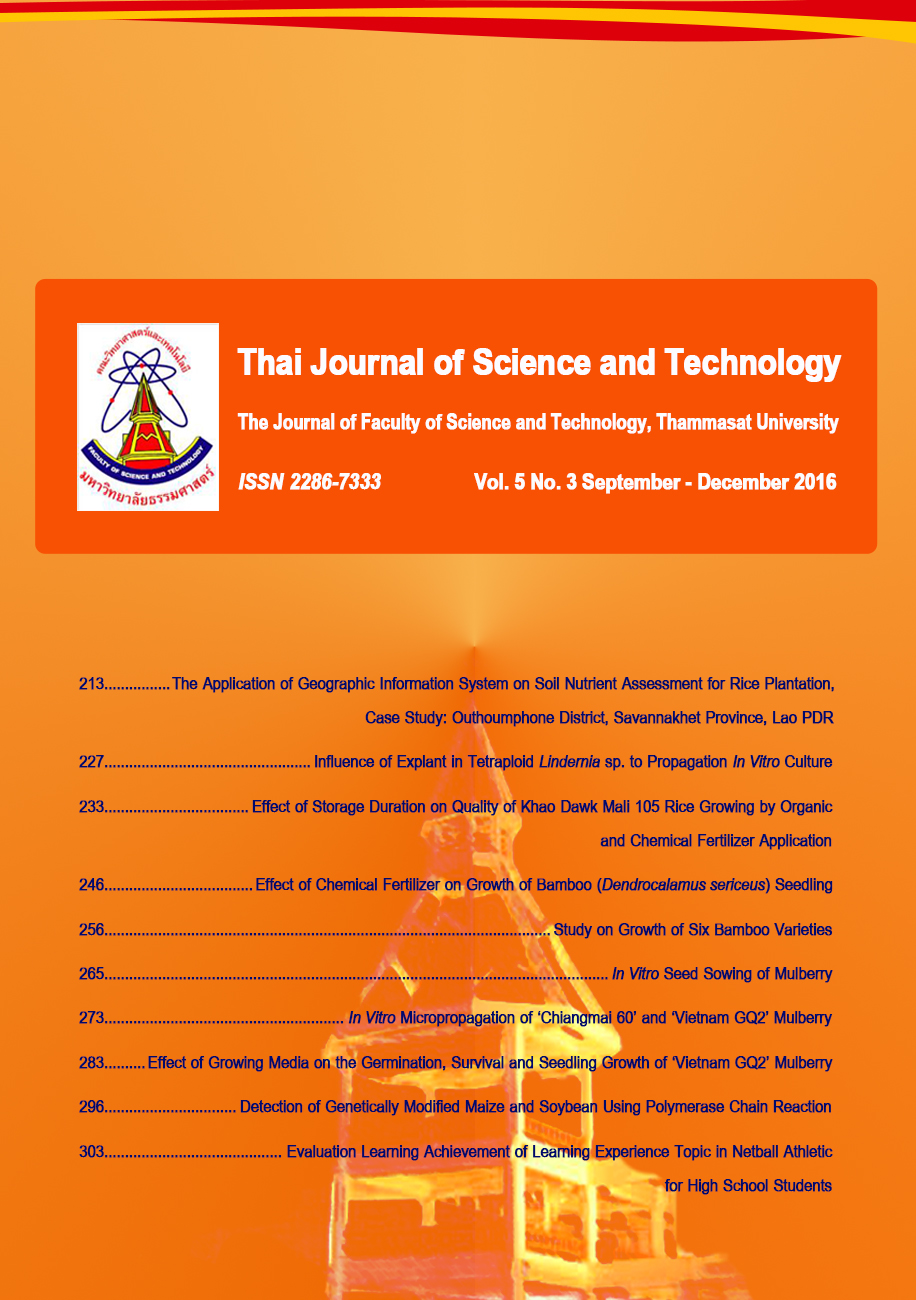การเพาะเมล็ดมัลเบอร์รี่ในสภาพปลอดเชื้อ
Main Article Content
Abstract
บทคัดย่อ
การศึกษาวิธีการฟอกฆ่าเชื้อ การงอกของเมล็ด และการเจริญเติบโตของมัลเบอร์รี่ในสภาพปลอดเชื้อ โดยการฟอกประกอบด้วย 5 กรรมวิธี ได้แก่ (1) คลอรอกซ์ 20 % นาน 10 นาที ตามด้วยคลอรอกซ์ 10 % นาน 10 นาที (2) คลอรอกซ์ 20 % นาน 5 นาที ตามด้วยคลอรอกซ์ 5 % นาน 10 นาที (3) คลอรอกซ์ 10 % นาน 10 นาที ตามด้วยคลอรอกซ์ 5 % นาน 10 นาที (4) คลอรอกซ์ 10 % นาน 10 นาที ตามด้วยคลอรอกซ์ 5 % นาน 15 นาที (5) คลอรอกซ์ 10 % นาน 20 นาที และ (6) คลอรอกซ์ 5 % นาน 20 นาที พบว่าการฟอกทุกกรรมวิธีไม่มีความแตกต่างทางสถิติ โดยการฟอกด้วยคลอรอกซ์ 10 % นาน 10 นาที ตามด้วยคลอรอกซ์ 5 % นาน 15 นาที มีเปอร์เซ็นต์ที่ไม่เกิดการปนเปื้อนของเมล็ดสูงที่สุด คือ 96.67 % การศึกษาผลการงอกของเมล็ดมัลเบอร์รี่ ‘เวียดนาม GQ2’ มีเปอร์เซ็นต์การงอกสูงที่สุด คือ 70 % รองลงมา คือ ‘ไต้หวัน 203’ และ ‘ไต้หวัน Miaoli No.1’ (61.67 และ 60 % ตามลำดับ) ในขณะที่ ‘ไต้หวัน 46C019’ ไม่เกิดการงอกของเมล็ด จึงทดสอบการทำลายการพักตัวของเมล็ดมัลเบอร์รี่ ‘ไต้หวัน 46C019’ ในสภาพปลอดเชื้อ พบว่าการขลิบและไม่ขลิบเมล็ดแล้วนำไปเพาะเลี้ยงในอาหารสูตร MS ที่ผสมด้วยจิบเบอเรลลิค แอซิด ความเข้มข้น 500 มิลลิกรัม/ลิตร เมล็ดมีเปอร์เซ็นต์การงอก 8.33 % สำหรับการเจริญเติบโต พบว่ามัลเบอร์รี่ที่มีการเจริญเติบโตได้ดี คือ ‘ไต้หวัน 108’ และ ‘ไต้หวัน 203’ ตามด้วย ‘เวียดนาม GQ2’ โดยมีความยาวราก ความสูงต้น และความยาวใบสูงที่สุด
คำสำคัญ : การฟอกฆ่าเชื้อ; การงอกของเมล็ด; การเจริญเติบโต; การทำลายการพักตัว
Abstract
This experiment studied on surface cleaning, seed germination and growth of mulberry seedling in vitro culture. Surface sterilization consist of 6 methods: (1) 20 % Chlorox® for 10 min, then 10 % Chlorox® for 10 min, (2) 20 % Chlorox® for 5 min, then 5 % Chlorox® for 10 min, (3) 10 % Chlorox® for 10 min, then 5 % Chlorox® for 10 min, (4) 10 % Chlorox® for 10 min, then 5 % Chlorox® for 15 min, (5) 10 % Chlorox® for 20 min, and (6) 5 % Chlorox® for 20 min. The results showed that all of method for surface cleaning were no significant different, by soaking in the 10 % Chlorox® for 10 min, then 5 % Chlorox® for 15 min gave the highest percentage of the uncontaminated seed (96.67 %). In the mulberry seed germination experiment, ‘Vietnam GQ2’ gave the maximum of seed germination (70 %) follow by ‘Taiwan 203’ and ‘Taiwan Miaoli No.1’ (61.67 and 60 %, respectively). Whereas, ‘Taiwan 46C019’ was no germination of seed. Therefore, effect of break dormancy on ‘Taiwan 46C019’ mulberry seed germination in vitro culture was studied. Result showed that clipping and unclipping seed culture on MS media which contained gibberellic acid have the germination rate 8.33 %. For the growth experiment, ‘Taiwan 108’, ‘Taiwan 203’ and ‘Vietnam GQ2’ mulberry were well growth of seedling, that have the best on root length, stem length and leaf length.
Keywords: surface sterilization; seed germination; growth; break dormancy
Article Details
บทความที่ได้รับการตีพิมพ์เป็นลิขสิทธิ์ของคณะวิทยาศาสตร์และเทคโนโลยี มหาวิทยาลัยธรรมศาสตร์ ข้อความที่ปรากฏในแต่ละเรื่องของวารสารเล่มนี้เป็นเพียงความเห็นส่วนตัวของผู้เขียน ไม่มีความเกี่ยวข้องกับคณะวิทยาศาสตร์และเทคโนโลยี หรือคณาจารย์ท่านอื่นในมหาวิทยาลัยธรรมศาสตร์ ผู้เขียนต้องยืนยันว่าความรับผิดชอบต่อทุกข้อความที่นำเสนอไว้ในบทความของตน หากมีข้อผิดพลาดหรือความไม่ถูกต้องใด ๆ


